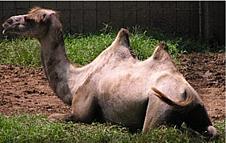Bactrian Camel
|
|
| Bactrian camel Conservation status: Critical | ||||||||||||||
|---|---|---|---|---|---|---|---|---|---|---|---|---|---|---|
 Bactrian camel | ||||||||||||||
| Scientific classification | ||||||||||||||
| ||||||||||||||
| Binomial name | ||||||||||||||
| Camelus bactrianus Linnaeus, 1758 |
The Bactrian camel (Camelus bactrianus) is a large even-toed ungulate native to the steppes of eastern Asia. Nearly all of the estimated 1.4 million Bactrian camels alive today are domesticated, but in October 2002 the estimated 950 remaining in the wild in northwest China and Mongolia were placed on the critically endangered species list.
Appearance and habitat
Camel_zoo.JPG
Bactrian camels are over 2 meters (7 feet) tall at the hump and weigh in excess of 725 kg (1,600 pounds). They are herbivores, eating grass, leaves, and grains, capable of drinking up to 120 litres (32 US gallons) of water at a time. Their mouth is extremely tough, allowing them to eat thorny desert plants.
They are supremely adapted to protect themselves against the desert heat and sand; with wide, padded feet and thick leathery pads on the knees and chest, nostrils that can open and close, ears lined with protective hairs, and bushy eyebrows with two rows of long eyelashes. Thick fur and underwool keep the animal warm during cold desert nights and also insulate against daytime heat.
The Dromedary camel (Camelus dromedarius) is the only other surviving camel species, native to the Sahara desert, but today is extinct in the wild. By comparison the Bactrian camel is a stockier, hardier animal being able to survive the scorching desert heat of northern Iran to the frozen winters in Tibet [1] (http://www.abc.net.au/creaturefeatures/facts/camels.htm). The Dromedary is taller and faster, with a rider they can maintain 8-9 mph for hours at a time. By comparison a loaded Bactrian camel moves at about 2.5 mph [2] (http://www.ancientroute.com/resource/animals/camel.htm).
History
It is thought that the Bactrian camel was domesticated (independently from the Dromedary) sometime before 2500 B.C., probably in northern Iran or southwestern Turkestan. The Dromedary is believed to have been domesticated around 4000 B.C. in Arabia.
External links
National Geographic: Wild Bactrian Camels Critically Endangered (http://news.nationalgeographic.com/news/2002/11/1126_021205_cameltrek.html)
